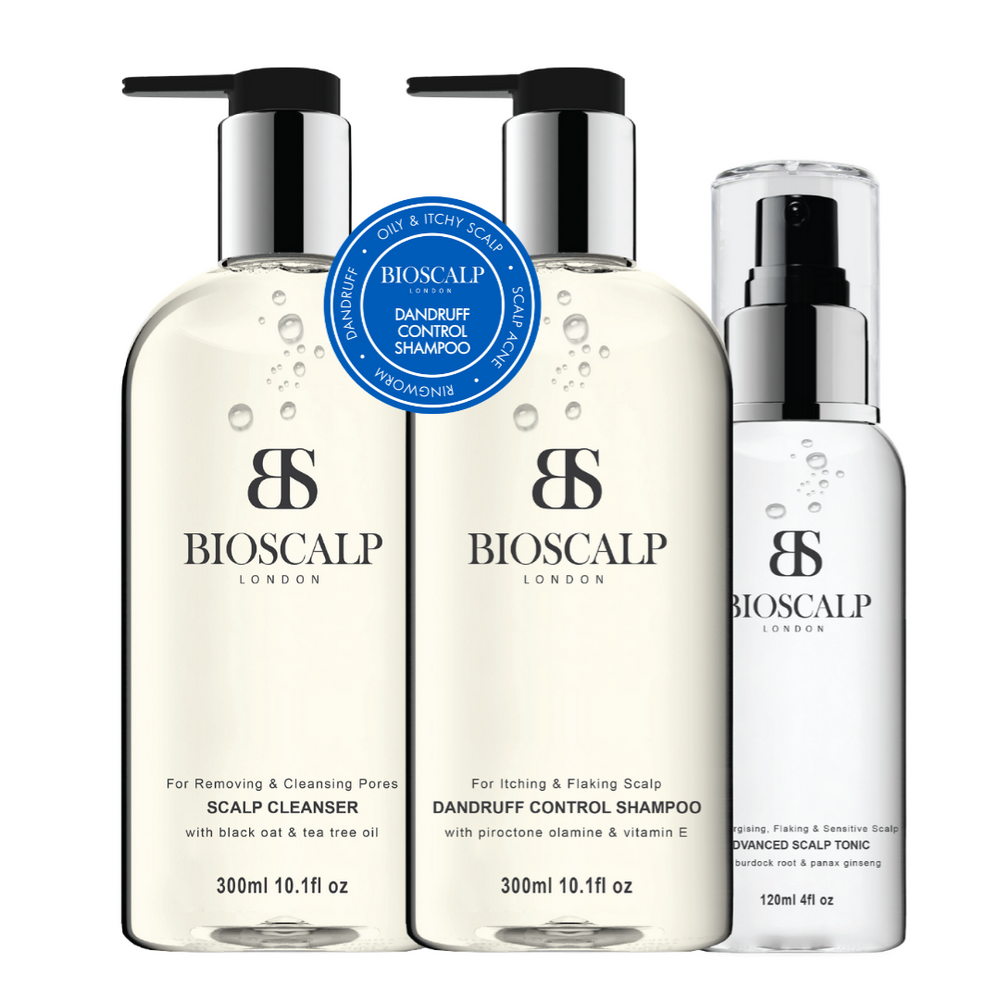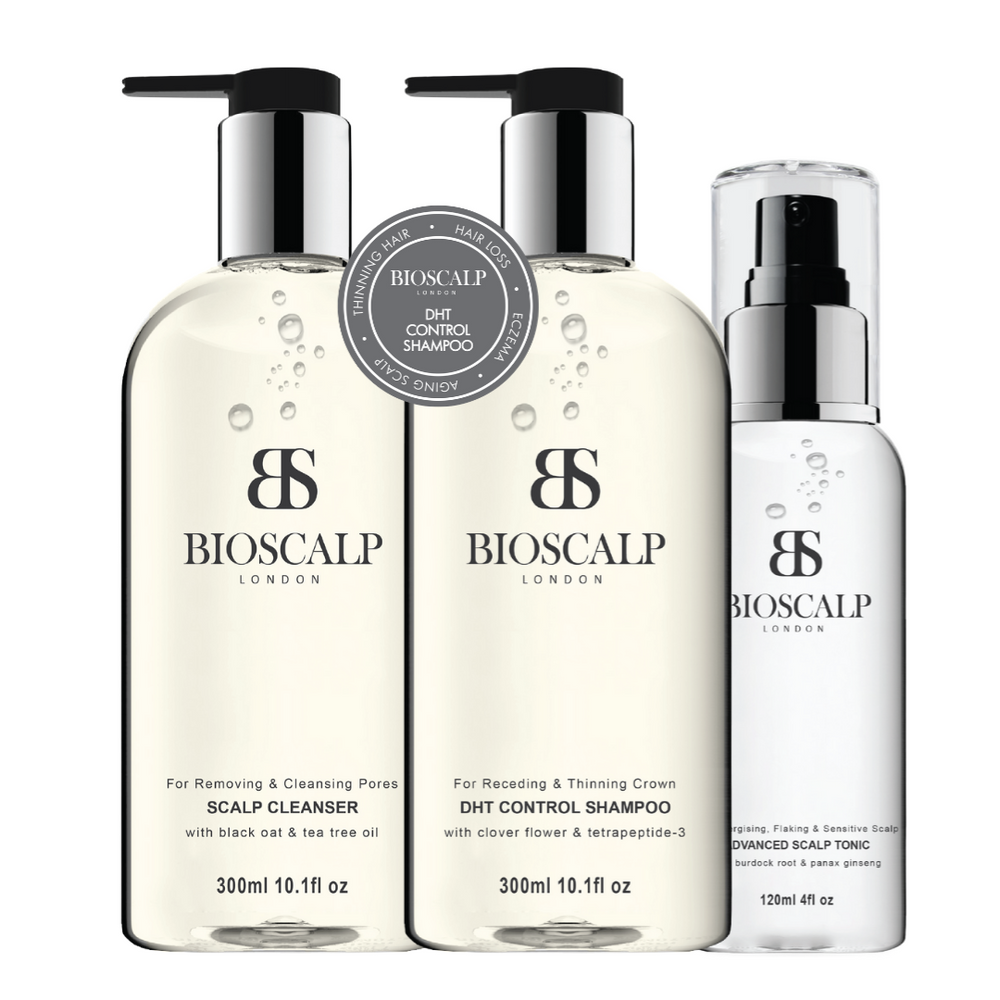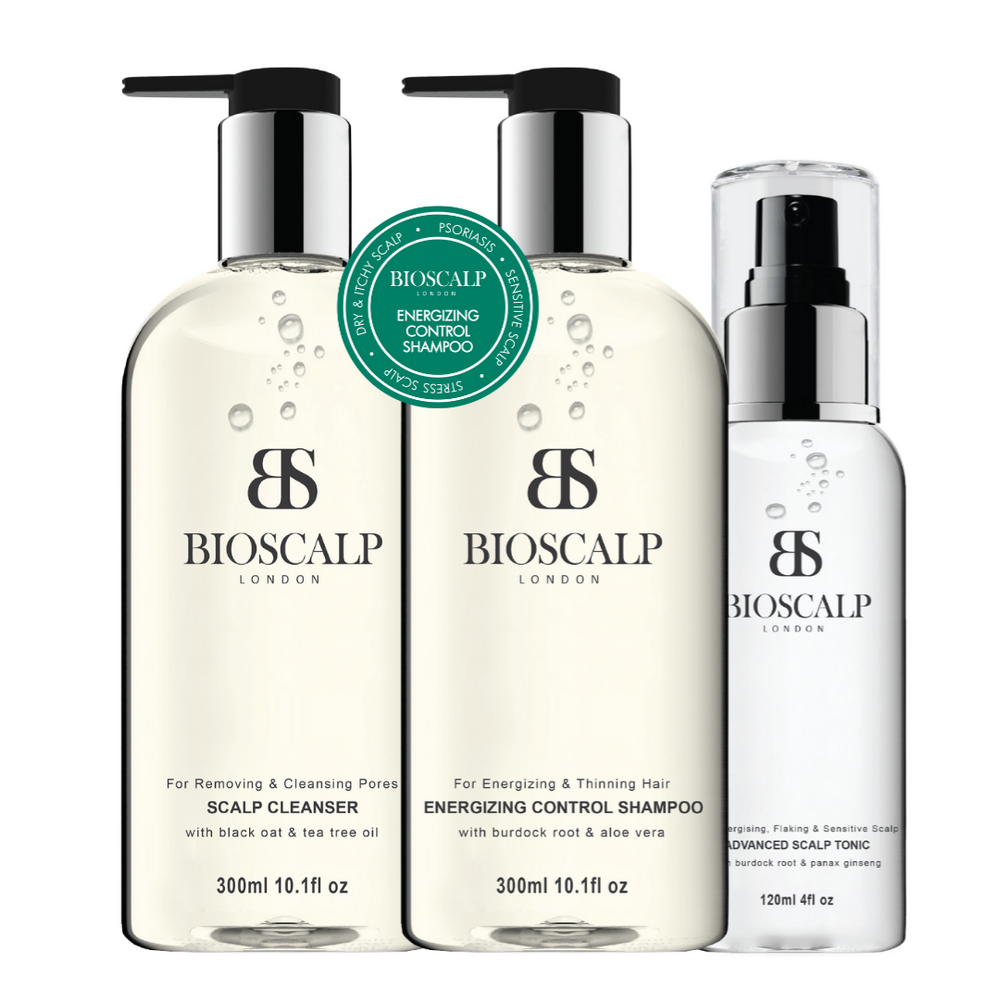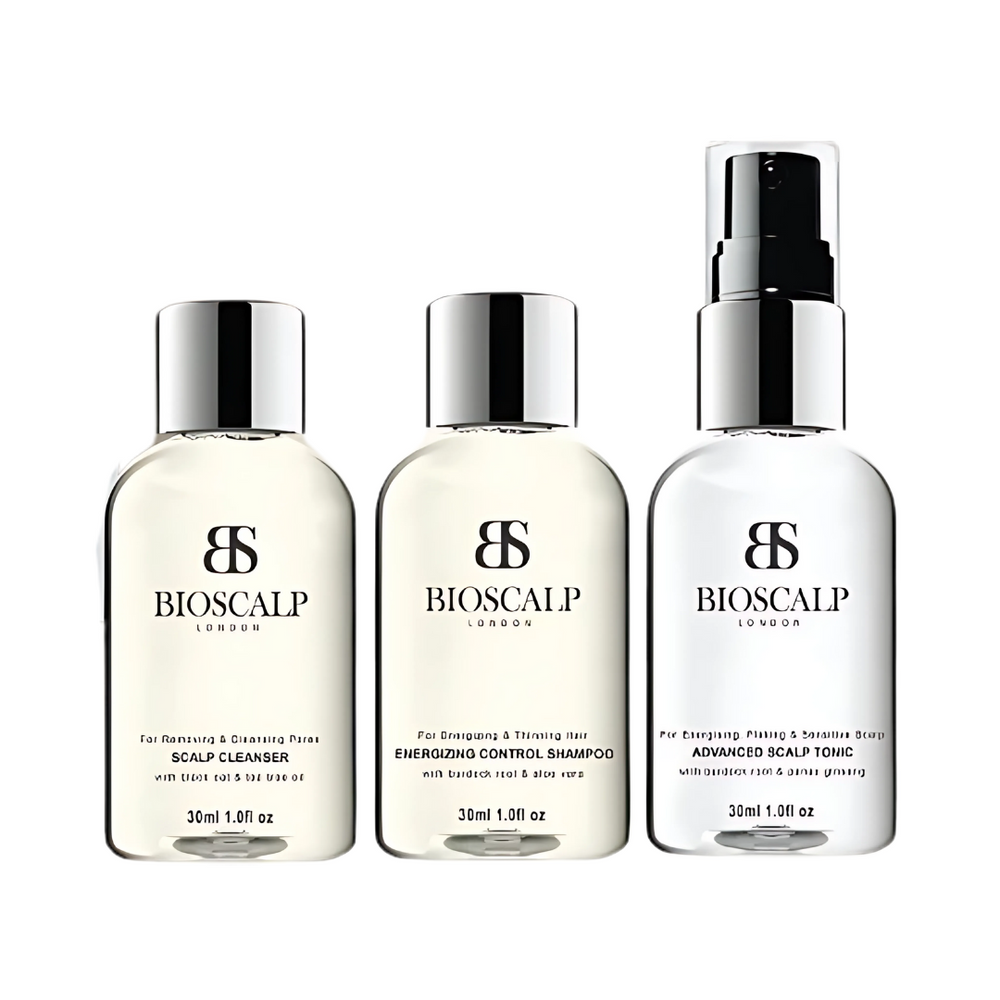For millions of people, seeing more hair in the brush or a thinning patch in the mirror is a source of genuine concern. This common condition, known as androgenetic alopecia (or more simply, male and female pattern hair loss) often has a single, powerful culprit at its core: a hormone called dihydrotestosterone, or DHT.
Understanding DHT is the first step to effectively managing hair loss. In this article, we’ll break down what DHT is, how it wreaks havoc on your hair follicles, and explore the science-backed strategies, from powerful medications to natural ingredients, that can help you fight back.

What is DHT and How Does It Cause Hair Loss?
Think of DHT as a super-potent version of testosterone. It’s created in your body when an enzyme called 5α-reductase (5-alpha-reductase) converts regular testosterone into DHT. While DHT plays a role in development earlier in life, for individuals with a genetic predisposition to hair loss, it becomes an enemy to the hair on their head.
DHT attaches to androgen receptors in your hair follicles, triggering a process called 'miniaturisation'. This causes the follicles to shrink, shortening the hair's growth phase. Over time, the hair that grows back becomes progressively shorter, finer, and lighter until the follicle eventually shuts down and stops producing hair altogether. The key to stopping this process is to reduce the amount of DHT interacting with your follicles.
The Gold Standard: Pharmaceutical DHT Inhibitors
The most effective medical treatments for hair loss work by directly targeting DHT production. These medications are known as 5α-reductase inhibitors.
Finasteride: The FDA-Approved Option for Men
Finasteride is a well-known oral medication specifically approved by the FDA to treat male pattern baldness. It works by selectively blocking the Type II 5α-reductase enzyme, which is the primary type responsible for creating DHT in hair follicles. By doing this, finasteride can slash DHT levels in the scalp by about 64% and in the blood by around 70%.
The clinical results are impressive. One major two-year study found that 83% of men taking finasteride experienced a halt in their hair loss, compared to only 28% in the placebo group. Many men also see a significant increase in hair count and overall hair appearance. However, it's a commitment; if you stop taking it, its benefits begin to fade within a couple of weeks.
Dutasteride: The More Potent Inhibitor
Dutasteride is another powerful oral medication that takes DHT inhibition a step further. Unlike finasteride, dutasteride blocks both Type I and Type II 5α-reductase enzymes. This dual-action approach makes it significantly more potent, capable of reducing serum DHT by over 90% and scalp DHT by a staggering 92%.
This superior DHT suppression often leads to better results, with studies showing it’s more effective than finasteride at increasing hair count and reversing miniaturization. While it is not FDA-approved specifically for hair loss (it's used "off-label"), many doctors prescribe it for this purpose. One key consideration is its long half-life; it can remain in your system for up to six months, meaning both its benefits and any potential side effects can linger long after you stop taking it.
| Feature | Finasteride | Dutasteride |
| Mechanism of Action | Selective Type II 5α-reductase inhibitor | Inhibits both Type I and Type II 5α-reductase |
| FDA Approval for Hair Loss | Yes, for male pattern baldness | No (off-label use for hair loss) |
| Typical Daily Dosage (for Hair Loss) | 1 mg | 0.5 mg (off-label) |
| Approximate DHT Reduction (Serum) | ~70% | >90% |
| Approximate DHT Reduction (Scalp) | ~64% | ~92% |
| Comparative Efficacy | Slows hair loss, promotes regrowth | Superior efficacy in hair count & miniaturization reversal |
| Half-life | Shorter (~2 weeks for effects to diminish) | Longer (~6 months in body) |
| Common Side Effects | Erectile dysfunction, decreased libido, ejaculation problems, depression, breast tenderness | Reduced sex drive, headaches, dizziness, nausea, impotence, breast tenderness |
| Special Considerations | Not for use in women | Contraindicated in women/children (teratogenic risk); blood donation restriction |
Important Note on Side Effects
While highly effective, these medications can have side effects, most commonly related to sexual function (e.g., decreased libido, erectile dysfunction). It is crucial to have a thorough discussion with a healthcare professional to weigh the risks and benefits before starting treatment.
A Targeted Approach for Women: Spironolactone
For women experiencing pattern hair loss, the hormonal picture can be different. Spironolactone is an anti-androgen medication often prescribed off-label to treat female pattern hair loss. Instead of just blocking DHT production, it works by directly blocking the androgen receptors on the hair follicles and reducing the body's overall production of androgens.
Studies show it can be very effective, with success rates between 70-80% in stopping hair loss and promoting regrowth in women. A temporary shedding phase can sometimes occur in the first few months, but this is typically a sign that the body is adjusting to the hormonal changes before new growth begins.

Nature's Arsenal: Natural DHT Inhibitors
For those seeking a more natural approach or a supplement to their existing regimen, several natural compounds have shown promise in inhibiting DHT and supporting a healthy scalp environment.
- Saw Palmetto: This popular herbal extract works similarly to finasteride by inhibiting the 5α-reductase enzyme and preventing DHT from binding to follicles. Some studies have shown it can improve hair quality and increase total hair count by up to 27%.
- Pumpkin Seed Oil: This oil contains a unique compound called cucurbitin, which is thought to block DHT. A placebo-controlled study showed that men taking pumpkin seed oil experienced an average of 40% more hair growth.
- Caffeine: More than just your morning pick-me-up, caffeine has been shown to stimulate hair follicles and extend their growth phase. It's a key ingredient in many topical treatments because it can be delivered directly to the source of the problem.
- Rosemary Oil: A 2015 study found that applying rosemary oil to the scalp produced hair thickness increases comparable to minoxidil (the active ingredient in Rogaine) over six months.
While natural inhibitors are generally considered less potent than their pharmaceutical counterparts, they can play a vital supportive role in a comprehensive hair care routine. Using products formulated with these ingredients can help create the optimal scalp environment for healthy hair growth.
| Natural Agent | Proposed Mechanism of Action | Level of Scientific Evidence | Reported Efficacy / Notes | Common Side Effects |
| Saw Palmetto | Nonselective 5α-reductase inhibitor; blocks DHT binding | Modest, requires more robust data | May improve hair count/density (e.g., 27% increase in total hair count) | Mild: Dizziness, headache, nausea, diarrhea. Can affect PSA levels |
| Pumpkin Seed Oil | Contains cucurbitin, thought to block DHT | Promising, but limited studies | 40% more hair on average in one study | Mild: Itching, mild stomach pain |
| Rosemary Oil | Extends hair growth phase, anti-inflammatory | Promising, but small sample sizes | Similar hair thickness increase to minoxidil in one study | Not specified in provided texts |
| Green Tea (EGCG) | May inhibit 5α-reductase; antioxidant | Inconclusive; more research needed | Contains beneficial nutrients; potential for 5α-reductase inhibition | Not specified in provided texts |
| Caffeine | Promotes hair growth; extends growth phase | Limited as standalone treatment; often combined | Can extend hair follicle growth phase | Not specified in provided texts |
| Antioxidants (e.g., Vitamin E) | Blocks DHT-induced TGF-β release; neutralizes ROS; reduces inflammation | Supportive evidence for hair health | Improves hair counts by reducing oxidative stress | Generally safe at recommended doses |
| Unsaturated Fatty Acids | Inhibits 5α-reductase activity (e.g., gamma linolenic acid) | Supportive evidence for hair health | May improve growth factor expression in DPCs | Not specified in provided texts |
Building Your Strategy Against DHT
Tackling hair loss caused by DHT requires a consistent and targeted approach. While oral medications offer a powerful systemic solution, a holistic strategy that includes topical support is often the best path forward.
Incorporating a specially formulated shampoo is an excellent first step. A high-quality DHT-inhibiting shampoo can help cleanse the scalp of excess DHT and deliver natural blocking agents like caffeine and saw palmetto directly to the follicles.
For a more comprehensive routine, consider a complete system like the Hair Loss Shampoo Set, which combines targeted ingredients to not only block DHT but also to nourish the scalp and strengthen existing hair.
Ultimately, understanding the role of DHT empowers you to take control of your hair health journey. Whether you choose a medical, natural, or combined approach, always consult with a healthcare professional to create a plan that is safe and effective for you.









